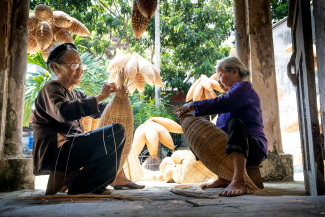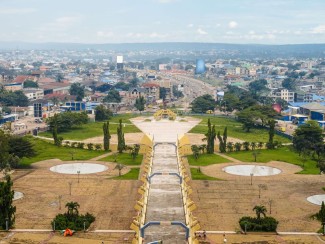In West Africa where most shea originates, it is traditionally women that collect shea nuts from nearby parklands, turning the oily kernels within into smooth shea butter. This requires many stages and processes, from the labor of collection and carrying to the work of boiling, drying, shelling, roasting and pounding.
The effort is time-consuming and arduous, and is done by rural people living in some of the world’s poorest countries.
Now that shea is big in beauty circles and pharmaceuticals due to its nutrient rich and anti-inflammatory properties, there is opportunity to try and guide the profits from sales of creams, salves and balms to the people who need it most, meaning women in countries like Benin and Burkina Faso and Togo.
Key to getting shea collectors and processors good pay is wielding the power of community rather than individuals. Efforts by local and regional institutions and international development partnerships – who are also keeping in focus private financing – are assisting people working in the shea sector across West Africa. This includes helping women form cooperatives, through which they can improve their incomes and their production skills so their shea butter is up to international standards, and work together to advocate for better prices and access needed funding.
“For more than 10 years there was no organization in place. We have received strong support from the Global Shea Alliance [GSA] based in Accra. Now, there are more than 70 registered women’s cooperatives across more than 700 villages,” said Armand Kingbo, National Coordinator of the Shea Association of Benin (AKB), an organization that provides support and advocacy for shea sector workers in the country.
The GSA, a non-profit with members across 36 countries that includes the private sector and non-governmental and civil society organizations, helps small shea businesses create links to markets, and works to develop sustainability throughout the industry.
One initiative the GSA is leading (with US$2.5 million in support from the Enhanced Integrated Framework (EIF), $850,000 from the GSA and the United States Agency for International Development (USAID) and $264,000 from the private sector) is addressing multiple parts of the shea value chain. Fifty warehouses will be built across Benin, Burkina Faso, Mali and Togo to house thousands of tons of shea products. Such facilities are much needed by women’s shea cooperatives as individual households usually have nowhere to store shea nuts, kernels and butter. The GSA estimates that women can earn 30-50% more as a result of access to storage.
Kingbo of the AKB said, “A challenge is that the women’s cooperatives do not control the price fluctuations. The market dropped significantly in 2020 as a result of COVID-19, which created difficulties for the cooperatives here because they could not sell their products with better offers.”
“Our goal is to open up the Beninese shea actors to other markets, such as in Asia and North America. The value chain is not using shea efficiently, and if we can break into new markets there will be competition and prices could multiply by 2 or 4 times,” he said.
Money has been flowing to mitigate pandemic-induced issues and support value chains. For example, the West Africa Trade & Investment Hub is funding the Togo-based Alaffia with US$299,000 to help them manage the disruptions and loss of orders due to COVID-19.
Funded by USAID, the West Africa Trade & Investment Hub works to spur trade by supporting small businesses to catalyze their investment and export abilities. The investments from the US$96 million grant facility generally go to enterprises involved in agricultural supply chains like rice and cashews that have the ability to generate exports within and outside the region. The support to Alaffia is their first in the shea sector as part of COVID-19 grants dedicated to businesses operating in West Africa that have been affected by the pandemic.
“When we spoke with Alaffia we saw the impact. We saw the increased costs that they had – instead of the regular shipments that they would do by sea, for some of their products they had to stop shipping, or they had to airlift them, at a much higher cost. So it really created a significant disruption in their supply chain,” said Etienne Chia-ah, Public Private Partnership Manager at the West Africa Trade & Investment Hub.
The funds are going to ensure market access for over 6,000 shea collectors to procure at least 700 metric tons of shea kernels from collectors, and retain more than 300 factory jobs in Togo.
“It's a sector that is of interest to us because of the huge impact that comes with the exports from here,” Chia-ah said, referencing the potential livelihood improvements.
Integral to the West Africa Trade & Investment Hub’s grantmaking is that businesses work with the private sector to leverage the grants, with a preference of a five to one ratio with funds coming from private equity funds, banks or private foundations.
“In the case of Alaffia, we hope that as trade rebounds the sales that they will generate and the exports that they will generate will pay back on some of the costs, such as getting additional raw materials and being able to produce more shea butter or soap or other products. We are already seeing that pay off, and a key requirement for us is having that private sector investment,” Chia-ah said.
Shea products like soaps and creams are sold in small stores in Burkina Faso.
Protecting shea trees themselves is also a necessary consideration, as they can take 15-20 years to mature and become productive, and researchers have had limited success cultivating them, although research is still in process. Although shea’s importance in rural communities means the trees are allowed to grow whereas others might be felled to make way for farming or to use as charcoal, there is increasing pressure on shea trees.
The GSA recently launched a Parkland Restoration Fund to mobilize resources to restore shea parklands, with estimates showing that approximately eight million trees are lost every year due to removal, population pressures and commercial agriculture. They are looking to raise US$65.5 million to fund the cost of planting 10 million trees and protecting 4 million hectares of shea parklands.
Nearly two billion shea trees grow naturally on parklands in 21 African countries from Senegal to South Sudan, and 16 million women collect shea nuts or work on the processing side, according to the GSA.
In Benin, the challenges women face include difficulties accessing shea collection sites as they are increasingly distant from villages; insufficient equipment like basins, gloves and quality control items to measure pH and moisture levels; and access to suitable credit, according to Kingbo.
The GSA’s initiative with EIF, using a partnership model that incorporates multiple kinds of funding, is addressing these concerns, including helping to put in place conservation plans so soil is healthy and trees are allowed to flourish, providing needed tools and connecting cooperatives to microfinance institutions.
“Our priority is the wellbeing of the women who are in these cooperatives. When there are professional buyers the market is negotiating a low price and it puts women in bondage. However, with the cooperatives, they can negotiate prices themselves, but they are unable to work directly with exporters because of market regulations in force,” Kingbo said. “But when there are unforeseen factors in the shea market, it is often the women’s cooperatives that suffer the most.”
There are many challenges for shea producers in West Africa, where there can be poor infrastructure, little understanding of international shea processing requirements and less power to advocate for fair prices.
“The shea producers are a family – the National Federation of Shea Nut and Butter Producers of Benin – and these women need to be taken into account more seriously. We need more cooperatives as not all collectors have joined yet. And we need structural investment for mechanized and industrialized production, storage warehouses, drying areas and other equipment and infrastructure,” Kingbo said.
If you would like to reuse any material published here, please let us know by sending an email to EIF Communications: eifcommunications@wto.org.


